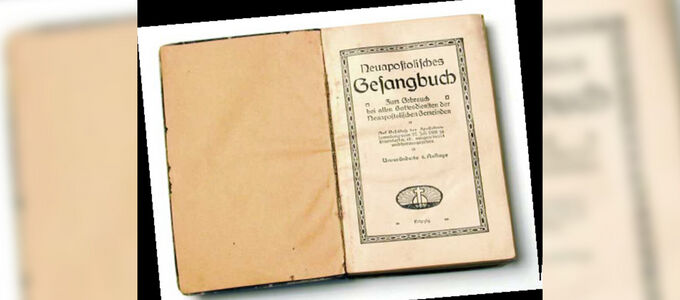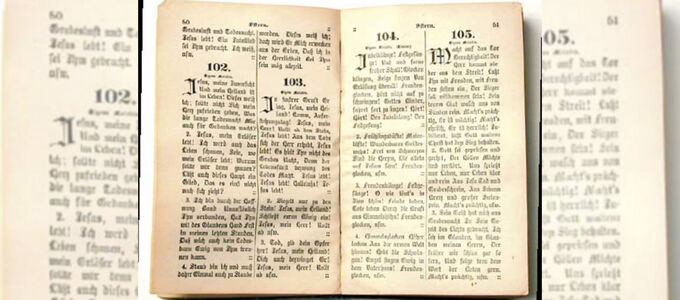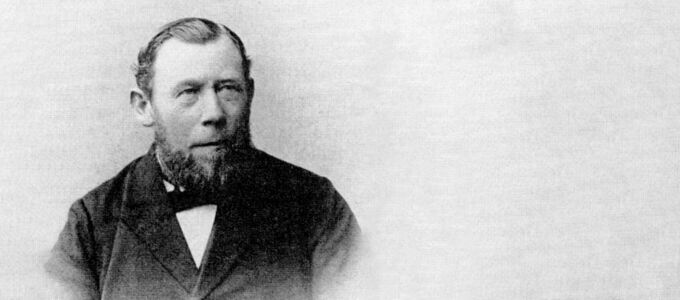
Some 125 years ago, Chief Apostle Friedrich Krebs ordained two men as Apostles who had already served the still young Church admirably. In addition to the ministry, the two men had things in common that still have an impact today.
Eliese and Friedrich, who tied the knot near Hamburg in Germany at the beginning of the twentieth century, not only shared their love for each other. Their fathers were both Apostles who helped the fledgling Apostolic Church develop in a similar way: Wilhelm Sebastian, the bride’s father, published a book on how divine services were to be structured and provided the young Wolfenbüttel congregation with a meeting place. And the groom’s father, Friedrich Wachmann, had published a liturgy book around twenty years earlier and bought the Hamburg-Borgfelde congregation its first church building.
Defining the liturgy
Heinrich Christian Friedrich Wachmann, born in 1841, was sealed in an outdoor service at the age of 22 together with the later Chief Apostle Krebs. He worked as a bricklayer, farmer, and baker and even as mayor on the side. In his free time, he was involved in the Church. From 1874, he provided a gathering place for the Hamburg congregation on his farm in Lurup, a city quarter of Hamburg. Five years later, on 21 September 1879, Friedrich Wachmann was ordained as a Deacon and six months later as a Priest.
Around this time, he compiled a liturgical book called The Liturgy. A Devotional Book for use in all Divine Services of the Apostolic Community. The book later came to be known by the term “Wachmann Liturgy” to distinguish it from its predecessor, the so-called Stechmann Liturgy, which contained mostly hymns. Wachmann’s liturgy contained information about the course and sequence of divine services on various occasions. However, Wachmann did not formulate all the prayers in their entirety. And the liturgy of the church services also changed. For example, Wachmann moved the Lord’s Prayer from its initial place at the start of the divine service to a new position preceding the celebration of Holy Communion. Beyond that, he did away with a number of liturgical hymns, antiphonal music, and Bible readings, which made the divine service shorter. The unscripted sermon was moved more into the focus of the divine service.
Praising, giving thanks, and buying a church building
With 180 hymns, the Wachmann Liturgy also contained significantly more hymns than its predecessor by Apostle Stechmann. New American revivalist songs were added to the existing Protestant repertoire. The 32 songs in the first part of this devotional book were for normal divine services and church holy days. The second part of the book focused on texts for baptisms, confirmations, and weddings, each of which was accompanied by a set of appropriate songs. This was followed by a section called “Hymns of praise and thanksgiving”, which contained 57 songs, although not all of them dealt with praise and thanksgiving. The third part of the book, designated as appendix, contained a further 18 songs sourced from free church denominations.
At the request of his leader Friedrich Krebs, Friedrich Wachmann—by then he was a Bishop—left his farm in 1893 and moved to be closer to the central congregation of Hamburg. That same year, he bought the Hamburg-Borgfelde congregation its first own church building.
Young and lots of responsibility
Wilhelm Christian Sebastian was born in 1846 and was sealed by Apostle Carl Wilhelm Louis Preuss in 1868. He trained as a mechanical engineer and later founded a repair business for bicycles and sewing machines. He was also very active for the Church in Hamburg. When the then Elder and later Chief Apostle Krebs asked for help and Apostle Preuss asked young Wilhelm to go—he was just 26 years old—he did not object. He quit his job and moved to Brunswick.
As early as 1 June, police records state that he wanted to “establish a so-called Christian apostolic congregation with the purpose of serving Christianity”. A group of twenty people were already regularly gathering for services. He was soon given the ministry of Deacon. Shortly afterwards, he bought a plot of land for his sewing machine business and converted the barn on the property into a place of worship for the congregation. Wilhelm Sebastian was found in his shop less and less because he was constantly on the road for the Church.
More songs, shorter texts
“The decision to give the apostolic congregations a standardised church hymnal, which corresponds to the contemporary revealed faith in the mission of our Lord Jesus Christ to His Apostles and the works of mission established by them, has come from the apostolate awakened and re-established by God,” it said in the preface of the first New Apostolic hymnal. The hymnal, which included brief instructions for the ministers on how a divine service was to be structured, contained 390 songs. The songs were like those in the Wachmann Liturgy. The hymnal also contained a brief guide for the ministers on how prayers could be formulated and what could be said at special occasions. The texts were shorter than in the Wachmann Liturgy. In 1900, an appendix with 131 further songs followed, containing songs from free church denominations and more revivalist songs. However, the foreword emphasised: “The songs contained in it are partly composed by members of the Apostolic Church.” After his ordination as an Apostle, the special assignment that Wilhelm Sebastian had been given passed to Brother Karnstädt from Wolfenbüttel.
The two men of God, to whom the Church still owes a great deal today, died in 1903 and 1912 respectively.












